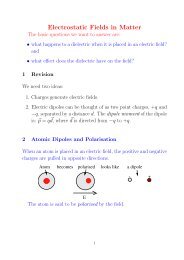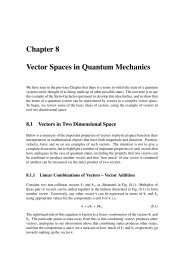Three-vector and scalar field identities and uniqueness theorems in ...
Three-vector and scalar field identities and uniqueness theorems in ...
Three-vector and scalar field identities and uniqueness theorems in ...
Create successful ePaper yourself
Turn your PDF publications into a flip-book with our unique Google optimized e-Paper software.
f<strong>in</strong>al two terms are now of the proper form yield<strong>in</strong>g thedesired identity∫∇ ′ · F(x ′ , y ′ , z ′ )F(x, y, z) = − ∇dV ′V 4πr∫′ ∇ ′ × F(x ′ , y ′ , z ′ )+ ∇ ×dV ′ (13)V 4πr′over all Euclidean three-space.A proof of Eq. (13) can be traced back to Stokes. 8 Nevertheless,Eq. (13) is sometimes referred to as a “Helmholtzidentity” (see Ref. 10). For an extended versionof Eq. (13) <strong>in</strong> a f<strong>in</strong>ite volume of R 3 the surface <strong>in</strong>tegralterms can be reta<strong>in</strong>ed. 6,9,10 Equation (13) is of the formof Eq. (2) <strong>and</strong> can therefore be considered as complet<strong>in</strong>gthe proof of theorem H1, provided that the <strong>in</strong>tegrals arewell def<strong>in</strong>ed. For the <strong>in</strong>tegrals to be well def<strong>in</strong>ed we mustassume that the <strong>field</strong> F vanishes sufficiently rapidly at<strong>in</strong>f<strong>in</strong>ity. As noted <strong>in</strong> Ref. 6, pass<strong>in</strong>g the rema<strong>in</strong><strong>in</strong>g <strong>vector</strong>derivatives over the <strong>field</strong> po<strong>in</strong>t coord<strong>in</strong>ates for a twicecont<strong>in</strong>uously differentiable <strong>vector</strong> <strong>field</strong> F <strong>in</strong>to each of therespective <strong>in</strong>tegrals of Eq. (13) can improve the convergenceproperties of the <strong>in</strong>tegr<strong>and</strong>s.To prove theorem U1 us<strong>in</strong>g the Helmholtz identity (13)for the (static) three-<strong>vector</strong> <strong>field</strong> F(r) we postulate theexistence of a second three-<strong>vector</strong> <strong>field</strong> G(r), which alsosatisfies Eqs. (1) <strong>and</strong> (13). That is, we replace F(r) onthe left-h<strong>and</strong> side of Eqs. (1a) <strong>and</strong> (1b) by G(r), leav<strong>in</strong>gthe right-h<strong>and</strong> side of Eqs. (1a) <strong>and</strong> (1b) unchanged. Thethree-<strong>vector</strong> <strong>field</strong> F(r) is unique if we can show thatW(r) ≡ F(r) − G(r) = 0. (14)If we take the divergence of W <strong>and</strong> use Eq. (1b), weobta<strong>in</strong>∇ · W = ∇ · F − ∇ · G = ρ − ρ = 0 (15)for all r <strong>in</strong> R 3 . We next take the curl of W <strong>and</strong> useEq. (1a) to obta<strong>in</strong>∇ × W = ∇ × F − ∇ × G = j − j = 0 (16)for all r <strong>in</strong> R 3 . The substitution of the results (15) <strong>and</strong>(16) for the three-<strong>vector</strong> <strong>field</strong> W <strong>in</strong>to the Helmholtz identity(13) yields the result W(r) = 0 which implies [viathe def<strong>in</strong>ition of W(r) <strong>in</strong> Eq. (14)] that F(r) = G(r)everywhere <strong>in</strong> R 3 . This proof implies that the (static)three-<strong>vector</strong> <strong>field</strong> F is uniquely determ<strong>in</strong>ed by Eqs. (1a)<strong>and</strong> (1b), thus prov<strong>in</strong>g theorem U1 on the <strong>uniqueness</strong> of(static) three-<strong>vector</strong> <strong>field</strong>s <strong>in</strong> terms of their curl <strong>and</strong> divergence,that is, <strong>in</strong> terms of a <strong>vector</strong> <strong>and</strong> a <strong>scalar</strong> (source)<strong>field</strong>, respectively. [For a f<strong>in</strong>ite volume of R 3 the normalcomponents W·n <strong>and</strong> tangential components W×n alsovanish <strong>in</strong> a similar fashion via a surface charge density σ<strong>and</strong> surface current density K, as can be shown for example<strong>in</strong> an explicit calculation for the case of a massive(static) three-<strong>vector</strong> <strong>field</strong>. 6 ]We now state the obvious. Equations (1a) <strong>and</strong> (1b) associatedwith theorem U1 are not equivalent to Maxwell’sequations, which uniquely specify the electromagnetic<strong>field</strong>s. They do not conta<strong>in</strong> any partial time derivativeterms <strong>and</strong> do not conta<strong>in</strong> any coupl<strong>in</strong>g between differentthree-<strong>vector</strong> <strong>field</strong>s. Therefore, Eqs. (1a) <strong>and</strong> (1b)<strong>and</strong> theorem U1 do not hold for time-vary<strong>in</strong>g electric<strong>and</strong> magnetic <strong>field</strong>s, which are examples of hyperbolicallypropagat<strong>in</strong>g 4 time-vary<strong>in</strong>g three-<strong>vector</strong> <strong>field</strong>s. Therefore,theorem U1 does not hold for all time-vary<strong>in</strong>g three<strong>vector</strong><strong>field</strong>s because there is at least one counterexample,that is, electromagnetism.In contrast, the Helmholtz theorem H1 is quite different<strong>in</strong> scope. It is essentially a projection theorem whichuses three-<strong>vector</strong> analysis to project out the longitud<strong>in</strong>al(irrotational) parts (which have zero curl) <strong>and</strong> transverse(solenoidal) parts (which have zero divergence) ofan arbitrary three-<strong>vector</strong> <strong>field</strong>, <strong>and</strong> states that any three<strong>vector</strong><strong>field</strong> can be represented as a sum of these twoparts. To show that this theorem holds even for timedependentthree-<strong>vector</strong>s, it is sufficient to verify the stepsemployed <strong>in</strong> deriv<strong>in</strong>g the Helmholtz identity (13), becauseit is of the proper form of Eq. (2), which is sufficientto prove theorem H1. Follow<strong>in</strong>g this l<strong>in</strong>e of reason<strong>in</strong>g,first observe that the delta function <strong>in</strong>tegral property<strong>in</strong> Eq. (7b) holds even for well-behaved time-vary<strong>in</strong>gthree-<strong>vector</strong> functions F(x, y, z, t) because the space <strong>and</strong>time variables are <strong>in</strong>dependent, <strong>and</strong> consequently space<strong>and</strong> time <strong>in</strong>tegrations are performed separately. As forEq. (8), it is a three-<strong>vector</strong> identity over the Euclidean<strong>vector</strong> space R 3 <strong>and</strong> over the associated <strong>scalar</strong>s <strong>in</strong> thereal number <strong>field</strong> R which applies to any (even timedependent)three-<strong>vector</strong> because it is based on multiplicationof <strong>vector</strong>s by <strong>scalar</strong>s (a def<strong>in</strong><strong>in</strong>g property of a <strong>vector</strong>space) <strong>and</strong> on the two pr<strong>in</strong>cipal ways that <strong>vector</strong>s canbe multiplied by each other <strong>in</strong> R 3 , that is, dot <strong>and</strong> crossproducts. [More formally, for A as a time-dependentvariable, Eq. (8) forms a one parameter family of <strong>vector</strong><strong>field</strong>s parametrized by t. For each time t, Eq. (8) holds.The same can be said for Eq. (7b).] Equation (8) is oftenused <strong>in</strong> deriv<strong>in</strong>g the spatial parts of wave equations <strong>and</strong>is the pr<strong>in</strong>cipal <strong>vector</strong> identity that leads to the decomposition(2). For the same reasons the <strong>vector</strong> <strong>identities</strong>(10) <strong>and</strong> <strong>in</strong>tegral <strong>identities</strong> (12) are valid for time-vary<strong>in</strong>g<strong>field</strong>s. Therefore, the Helmholtz identity (13) holds evenfor time-vary<strong>in</strong>g three-<strong>vector</strong> <strong>field</strong>s <strong>and</strong> so Helmholtz’stheorem H1 follows for them as well via Eq. (2).Helmholtz’s theorem H1 has been used frequently withtime-vary<strong>in</strong>g <strong>field</strong>s <strong>in</strong> both classical <strong>and</strong> quantum mechanicalcontexts. Rohrlich 3 has demonstrated that thisHelmholtz decomposition holds even for electromagneticsources, provided that the sources are bounded <strong>in</strong> space.This latter requirement is essentially equivalent to thecase of the general <strong>field</strong>s discussed here which are assumedto vanish sufficiently rapidly at <strong>in</strong>f<strong>in</strong>ity <strong>in</strong> unboundedR 3 . The relevant requirement <strong>in</strong> a bounded volumeV of R 3 is that the <strong>vector</strong> (or <strong>scalar</strong>) <strong>field</strong> must besufficiently smooth, 6 that is, a twice cont<strong>in</strong>uously differentiablefunction on the union of V <strong>and</strong> its bound<strong>in</strong>gsurface S, <strong>in</strong> order that a Helmholtz identity <strong>in</strong> a f<strong>in</strong>ite3
















